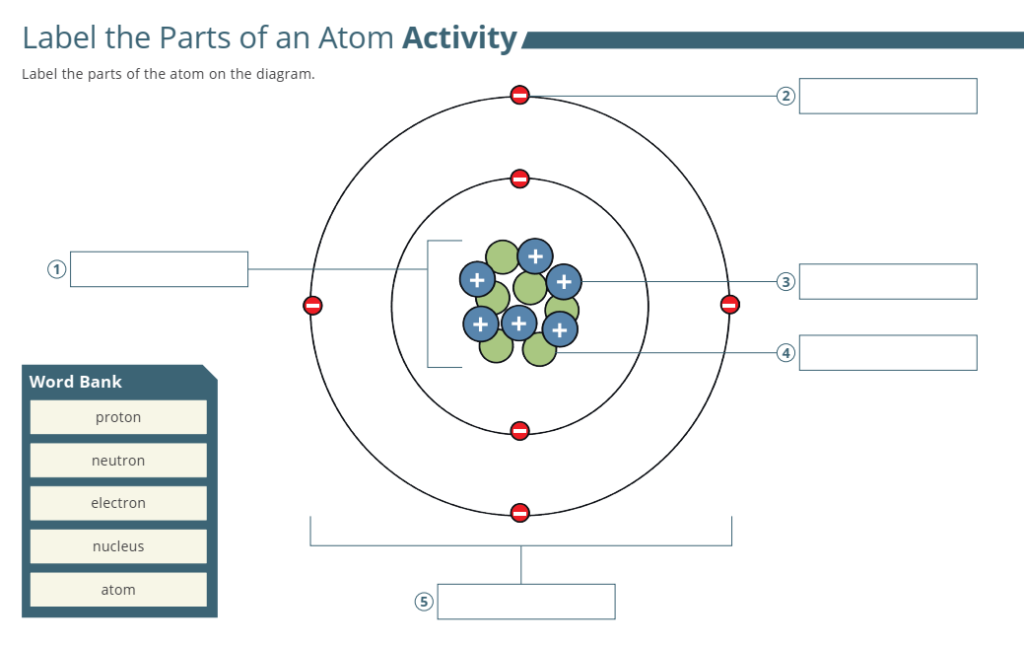Introduction
Atomic structure worksheets are important for understanding atomic structure. It is a fundamental concept in chemistry and physics. Atoms are the building blocks of matter, and learning about their structure helps us understand how elements interact, form compounds, and participate in chemical reactions. A strong foundation in atomic structure is essential for students pursuing science-related fields.
Worksheets are a great way to reinforce learning by providing hands-on practice. They include exercises such as labeling atomic diagrams, calculating atomic numbers, and arranging electrons in shells. By working through these exercises, students can enhance their understanding of atomic structure in an interactive way.
What is an Atom?
Definition of an Atom
An atom is the smallest unit of matter that retains the properties of an element. It consists of a dense nucleus surrounded by a cloud of electrons. Atoms combine in various ways to form molecules, which make up everything we see around us, from water to living organisms.
Atoms are incredibly tiny, typically measuring around 0.1 nanometers in diameter. Despite their small size, they contain all the information necessary to determine the physical and chemical properties of an element. Understanding atoms helps us grasp concepts such as bonding, chemical reactions, and states of matter.
Components of an Atom
An atom consists of three primary particles: protons, neutrons, and electrons. Protons are positively charged and are found in the nucleus. Neutrons, which have no charge, are also located in the nucleus, helping to stabilize it. Electrons are negatively charged and orbit the nucleus in defined energy levels.
Each component plays a vital role in determining the properties of an atom. The number of protons defines the element, while neutrons contribute to atomic mass and stability. Electrons are responsible for forming chemical bonds, allowing atoms to interact and create complex substances.
Structure of an Atom
Protons, Neutrons, and Electrons
Atoms are composed of three fundamental particles: protons, neutrons, and electrons. Protons carry a positive charge and define the element’s identity. For example, an atom with one proton is always hydrogen, while an atom with six protons is carbon. Neutrons have no charge but add mass to the atom, influencing its stability.
Electrons, on the other hand, are negatively charged and move around the nucleus in specific energy levels. They play a crucial role in chemical bonding and determine how atoms interact with one another. The balance between protons and electrons determines the atom’s overall charge.

Nucleus and Electron Shells
The nucleus is the central core of an atom, containing protons and neutrons. It is incredibly dense, accounting for nearly all of an atom’s mass. Despite this density, the nucleus is tiny compared to the overall size of the atom, as electrons occupy most of the surrounding space.
Electron shells, also known as energy levels, are regions around the nucleus where electrons are found. These shells follow specific rules, with the first shell holding up to two electrons and the second and third shells holding up to eight electrons each. The arrangement of electrons in these shells determines an atom’s chemical properties.
Atomic Number and Mass Number
Definition and Significance
The atomic number of an element represents the number of protons in its nucleus. This number is unique for each element and determines its position on the periodic table. For example, oxygen has an atomic number of 8, meaning it has eight protons in its nucleus.
The atomic number is crucial because it defines an element’s identity. Even if an atom gains or loses electrons, it remains the same element as long as its proton count does not change. This makes the atomic number a fundamental characteristic in chemistry.
How to Calculate Atomic Mass
The atomic mass (or mass number) of an atom is the total number of protons and neutrons in its nucleus. Since electrons have negligible mass, they are not included in this calculation. The formula for atomic mass is:
Atomic Mass = Number of Protons + Number of Neutrons
For example, carbon has six protons and usually six neutrons, giving it an atomic mass of 12. Some elements have different numbers of neutrons, leading to isotopes with varying atomic masses. Understanding atomic mass helps in calculating molecular weights and predicting how atoms will behave in reactions.
Isotopes and Ions
Definition of Isotopes and Examples
Isotopes are atoms of the same element that have different numbers of neutrons. While they have the same atomic number, their atomic masses vary. For example, carbon-12 and carbon-14 are both carbon isotopes, but carbon-14 has two extra neutrons.
Isotopes are important in various scientific fields. Radioactive isotopes, such as uranium-235, are used in nuclear power plants, while carbon-14 is used in radiocarbon dating to determine the age of fossils and artifacts.
Understanding Ions and Their Charges
Ions are atoms that have gained or lost electrons, resulting in a net charge. If an atom loses electrons, it becomes a positively charged ion (cation). If it gains electrons, it becomes a negatively charged ion (anion).
For example, sodium (Na) typically loses one electron to become Na+, while chlorine (Cl) gains one electron to become Cl−. Ions play a vital role in biological processes and chemical reactions, such as nerve function and the formation of salts.
Electron Configuration
Basics of Electron Arrangement
Electrons are arranged in energy levels or shells around the nucleus. The arrangement follows a specific pattern known as electron configuration. The first shell can hold up to two electrons, the second up to eight, and the third up to eighteen.
Electron configuration determines an element’s chemical behavior. Elements with full outer shells, like noble gases, are chemically stable, while those with incomplete shells tend to react with other elements to achieve stability.
Kindly Allow Pop ups to let the Download Begin!

How to Write Electron Configuration
Electron configurations are written using numbers and letters to represent energy levels and orbitals. For example, the electron configuration of oxygen (8 electrons) is 1s² 2s² 2p⁴. This notation helps scientists predict how elements will interact in chemical reactions.
Understanding electron configuration is crucial in chemistry, as it explains trends in the periodic table, such as reactivity and bonding patterns. It also helps in predicting the properties of newly discovered elements.
What is an Atom?
Conclusion
Atomic structure is a foundational concept in chemistry, helping us understand how elements interact and form compounds. By learning about protons, neutrons, electrons, isotopes, ions, and electron configurations, students gain valuable knowledge that applies to various scientific fields.
Worksheets are an effective tool for reinforcing these concepts through practical exercises. Whether labeling atomic diagrams or calculating atomic mass, practicing with worksheets enhances understanding and retention of atomic structure principles.
FAQs
1. Why is atomic structure important in chemistry?
Atomic structure determines how elements interact, bond, and form compounds. Understanding it helps explain chemical reactions and material properties.
2. How do isotopes differ from regular atoms?
Isotopes have the same number of protons but different numbers of neutrons, leading to variations in atomic mass without changing the element’s identity.
3. What is the significance of electron configuration?
Electron configuration determines an element’s chemical properties, reactivity, and bonding behavior by describing how electrons are arranged in energy levels.
4. How do ions form?
Ions form when atoms gain or lose electrons, resulting in a positive (cation) or negative (anion) charge. This process occurs in many chemical reactions.
5. What role do protons play in defining an element?
Protons determine an element’s identity. Changing the number of protons transforms the atom into a different element altogether.





